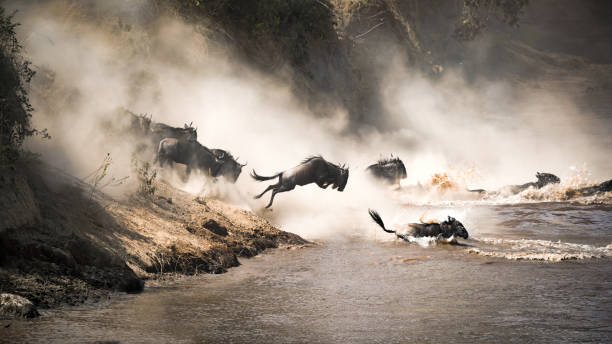Wildebeest Migration in Africa

The wildebeest migration in Africa is one of the most impressive natural wonders of the world. Every year, around 1.5 million wildebeests, along with thousands of zebras and gazelles, undertake a journey of over 1,800 miles across the Serengeti Plains in Tanzania and Kenya in search of fresh grazing grounds. This incredible event has captured the imagination of people all around the world, and it’s no surprise why.
Wildebeest Migration in Africa
The Wildebeest Migration in Africa: A Brief History
The wildebeest migration has been happening for centuries, but it wasn’t until the early 20th century that it became known to the rest of the world. The migration was discovered by a German explorer named Oscar Baumann, who was exploring the region at the time. Since then, the wildebeest migration has become a popular tourist attraction and is one of the most sought-after experiences for wildlife enthusiasts.
The Wildebeest Migration Route
The wildebeest migration is a cyclical event that takes place every year. It starts in the southern part of the Serengeti, where the wildebeest give birth to their young. As the dry season sets in, the wildebeest start moving north in search of fresh grazing grounds. They cross the Grumeti River and the Mara River, which are home to some of the largest crocodiles in Africa. The crossing is a treacherous journey and is one of the highlights of the migration.
As the wildebeest move further north, they are joined by thousands of zebras and gazelles. The migration reaches its peak in July and August when the wildebeest reach the Mara River. The Mara River crossing is a sight to behold as thousands of wildebeest gather on the banks of the river, waiting to cross. The crossing can take several days and is a dangerous journey. Many wildebeest are killed by crocodiles or drowned during the crossing.
Why the Wildebeest Migration is Important
The wildebeest migration is not just a natural spectacle, but it is also an important ecological event. The migration helps to replenish the grasslands of the Serengeti and Masai Mara, providing vital nutrients to the soil. The wildebeest and other grazing animals help to maintain the grasslands, preventing them from becoming overgrown and reducing the risk of wildfires.
The migration is also a vital source of food for the predators in the region. Lions, hyenas, and cheetahs rely on migration for their survival, and migration helps to maintain a healthy balance between predator and prey.
Visiting the Wildebeest Migration
If you want to experience the wildebeest migration for yourself, the best time to visit is between July and October. This is when the wildebeest are in the Masai Mara, and the river crossings take place. There are several ways to experience the migration, including hot air balloon rides, game drives, and walking safaris. There are also several lodges and camps in the region that offer accommodation.
When visiting the parks for the wildebeest migration, it is important to respect the wildlife and their habitat. Keep a safe distance from the animals and avoid disturbing them. It’s also important to follow the park rules and regulations to ensure the safety of all guests.
 Pay Now
Pay Now